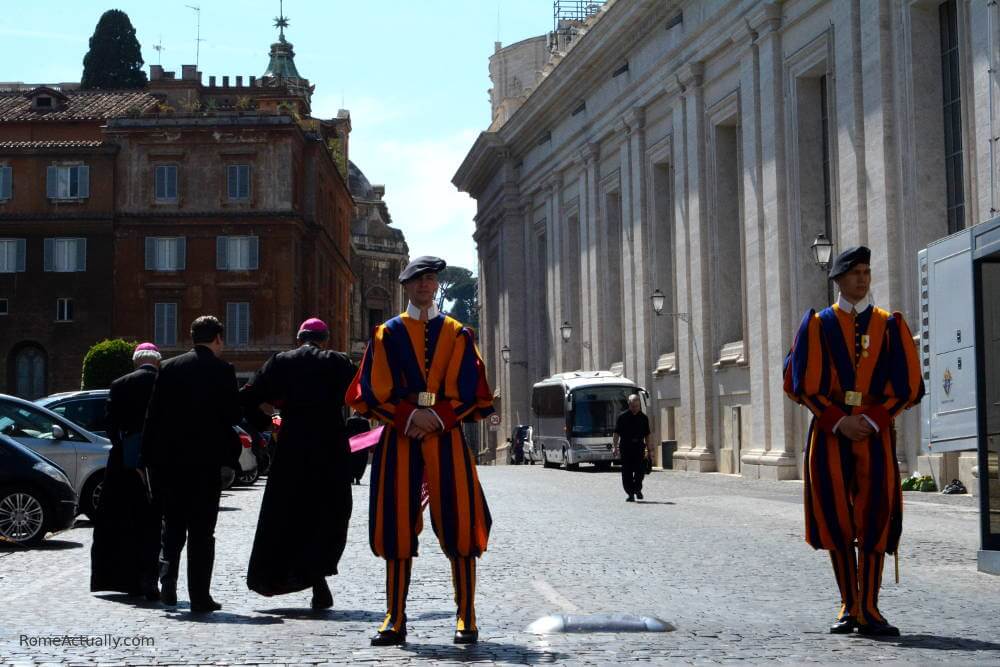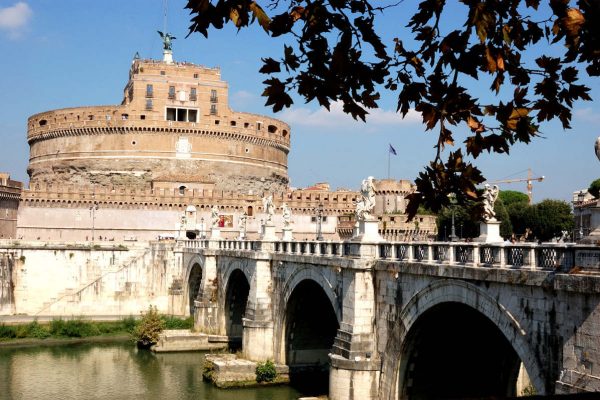One of the most popular landmarks in Rome, the Holy See is always surrounded by an aura of mystery. Something you will visit for sure whether you are in Rome for three days or one day only.
Of course, something to keep in mind when planning your trip is to follow the Vatican dress code to avoid being turned away at the entrance. Believe it or not, it has happened many times.
Here are some of the fascinating and interesting facts about the Vatican and curious bits of history behind it.
Interesting Vatican City facts and the history behind its walls
The Vatican is built on Saint Peter’s tomb
Actually, the Vatican Basilica, which is known as St. Peter’s Basilica, stands on top of Peter’s tomb. The first basilica was built in the 4th century by the will of Emperor Constantine on top of where the Apostle Peter was buried after being crucified upside down in Nero’s Circus. This is roughly where is St. Peter’s Square.
In fact, the famous bronze canopy inside the Basilica is placed exactly on top of the site where is Peter’s tomb in centuries of historical and architectural layers that show the continuing commemoration and respect towards the founder of Christianity.
For a better idea of where and how, you can visit the ancient necropolis beneath the Vatican Basilica. An official guide working for the Vatican will take you on a tour of the underground and will explain the history behind the place.
It’s actually a young state
The Vatican City as we know it, as an independent state inside the capital of unified Italy, is not that old.
In fact, it was established on February 11th, 1929 through the signing of the Lateran Treaties between the then Prime Minister Benito Mussolini and the then Holy See Chief Pope Pius XI.
It’s the world’s smallest state
Located on the right bank of the Tiber River, it covers an area of 44 hectares (0,44 sq. km), making it the world’s smallest country, even smaller than the tiny Monaco, one of the places to visit and things to do in the French Riviera. This is approximately the area of 60 soccer fields. The number of citizens is less than 900.

It is an absolute monarchy
Even though a tiny state, the Vatican has its own currency, police, prison, and laws. The Pope is the absolute monarch and Chief of the state and holds legislative, executive and judiciary power.
The Vatican citizens hold Vatican passports and around half of them don’t live in the Vatican but abroad for duty, usually diplomats.
Pretty much every country has two embassies in Rome, one to Italy and one to the Vatican State, adding the parking perpetual issue as many spaces are designated for diplomats.
READ MORE: To know what to see and do, check out our detailed guide to Vatican City.
Even though a young state, its history is very ancient
Although the modern Vatican City State as we know it was established in 1929, the history of the Vatican is way older and more complex than we might think. The first 1,000 years of existence of the Vatican are very obscure and the historic findings relating to this period are at times uncertain.
Before the fall of Rome and the Western Roman Empire, officially set in the year 476 AD, the history of Christianity is one of persecution. At least until AD 313, when Roman Emperor Constantine ruled religious tolerance and freedom with the Edict of Milan. We can still see much of its ancient history going down the Renaissance Basilica and visiting the ancient necropolis where St. Peter is buried as well as parts of the 4th-century Constantinian Basilica.
It wasn’t the first official residence of the Popes
The same emperor Constantine started an era of building important places for the Christian religion. In the 4th century, he built the Lateran Basilica, but it’s only from the 6th century that documented sources testify the place was the official papal residence. Before that, popes often lived in the catacombs mainly out of the urban area.
Popes gradually took control of Rome
The Popes only gradually started taking control of buildings inside the city. One of the main events was the transformation of the Pantheon from a pagan temple devoted to all gods to a Christian worship place in 609 AD.
Another milestone of early Christianity in Rome is when Pope John VII moved his residence to the Palatine Hill among the ruins of the ancient imperial palaces to be under the protection of the Byzantine Duke (representative of the Eastern Roman Empire) but also to start seizing places symbol of power.
After the fall of Ravenna as the capital of the Eastern Roman Empire in 750 AD, things started to change for the papal quest for power. Popes moved to the Lateran Basilica making it look majestic and apt to symbolize that from now on the ruling of the city was in their hands.
READ MORE: To skip the lines and for a deeper understanding of its art and history, check out our guide to the best tours to the Vatican.

The Popes lived in many different places in and out of Rome
Before settling in the actual Vatican, popes moved a lot to different places around Rome. Some of their residences were on the Aventine Hill (Santa Sabina Basilica), Santa Maria Maggiore basilica in the Esquilino Hill where famous artist Bernini is buried, and the Quirinale Palace, where now is Italy’s President, the building of which was commissioned by Gregory XIII and expanded by Sisto V.
Last but not least, some popes also lived in Castel Sant’Angelo, the spectacular Hadrian Mausoleum, where they sought refuge in times of foreign invasions and attacks. Pope Clemens VII escaped to Castel Sant’Angelo in 1527 during the Sack of Rome by the German Landsknecht mercenaries hired by Charles V who soon lost control over them.
They also lived outside Rome in cities like Assisi, Ferentino, Anagni, Tivoli, Orvieto, Perugia and Viterbo. Up to Avignon, in southern France, from 1309 to 1377, where they moved as Rome became unsafe due to dangerous and often bloody clashes between noble families, namely the Caetani and the Colonna.
The Vatican was mainly the place for religious celebration
Popes Niccolò V and Alessandro VI (the infamous Rodrigo Borgia) were the ones who started to settle for a longer time in the Vatican premises and began to embellish and build more parts, apartments, and wings. Officials and representatives of the Roman Curia were sent and operated in the city’s many districts, especially the Trevi area.
Gradually, the Quirinale Palace became the seat of the pope-king, where he would fulfill his functions as chief of the state, including governing a kingdom, defending their border, and keeping relations with the rest of the kingdoms in Europe and Italy, while the Vatican was for the pope bishop where religious celebrations would take place.

The Swiss Guards have been protecting the Pope since 1506
The Swiss Guards were first hired by Pope Julius III in 1506 because of their strength, noble sentiments, and legendary loyalty, all features that made them invincible.
Back in the day, the Swiss Cantons were very poor and the best and easiest way to make money was to migrate and become mercenaries for foreign states. This is how the Cantons played an important role in European politics.
In 1512, Pope Julius II gave them the title of “protectors of the freedom of the Church”.
Today, the Swiss Guards working as the armed forces of the Vatican are the only operative body left since foreign armies have been declared illegal by the other European states.
READ MORE: Want to know more about the Vatican? Check out our article on some interesting facts about St. Peter’s Basilica!
The Swiss Guards only swear on May 6th
May 6th is a sad anniversary for the Vatican and for the Army of the Swiss Guards. On this day in 1527, in fact, following the invasion of the Landsknecht of Charles V, the pope at the time, Clemens VII, ran away from the Vatican to hide in Castel Sant’Angelo.
There were 189 Swiss Guards to protect him and only 42 survived, while 147 died. This is why every year on May 6th, in the Vatican there is a ceremony to pay tribute to the victims and this is the only day when the new guards take the oath.
Italian unification was the end of the pope’s secular power
The incorporation of Rome into unified Italy put an end to the secular role of the pope as ruler of a kingdom to all effects and purposes and limited his powers as the spiritual guide of Christendom.
The Vatican is a UNESCO World Heritage Site
The Vatican has been declared a World Heritage Site by UNESCO for many reasons. As UNESCO itself puts it, it “attests to a great history and a formidable spiritual venture.”
Among the interesting Vatican City facts is that it’s the only UNESCO site to include a whole sovereign country.

With a history spanning over 2000 years and hosting some of the most important sites for Christians, it’s one of the main pilgrimage destinations and has played a pivotal role in Italian and European history and political development over the centuries.
Alongside its historical and political relevance, the Vatican is of extremely important artistic value. Only the Vatican Museums display five centuries of artwork collected by the popes through donations or their own commissions.
Pope John XXI went down in history as an alchemist
There are rumors and rumors. Some of the most disturbing for the Church and one of the quirky facts about the Vatican is that the only Portuguese pope, John XXI, was a passionate alchemist.
He lived in the Popes’ Palace of Viterbo and there he died in 1277 after only eight months of pontificate when the roof of his apartments collapsed. While the Church maintains the official reason for the accident, there are rumors that he died during one of his alchemy experiments.
It was common for popes to father children
That’s right, there are several popes who have fathered several children. In the past, in fact, it was pretty common for popes to have their own mistress, one or more than one.
Probably the most famous in this sense is Alexander VI, known as Pope Borgia. He fathered three sons and one daughter, Lucrezia Borgia, with his lover Vannozza Cattanei, when he was still a cardinal, albeit very powerful. After his relationship with Vannozza, he started an affair with the beautiful Giulia Farnese from Rome, an affair that carried on also after he became pope. With Giulia Farnese, he also had at least one child.
But he was not the only one. Other popes who had children were Cardinal Alessandro Farnese, later Pope Paul III, Cardinal Giuliano della Rovere, future Pope Julius II, and Pope Paul III among others.
READ MORE: Want to stay in the area? Check out our guide to the best hotels near Vatican City.
SAVE IT FOR LATER? PIN IT ON YOUR BOARD!





